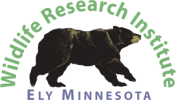2002-07-07 - Much has happened since spring
We have had so many good opportunities for public education, that many things have had to wait. Aside from travels to present public forums where people are learning to deal with bears in an increasingly urbanized environment, we have been preparing museum exhibits that will tour the nation, helping the North American Bear Center prepare for the opening of its first physical presence, conducting numerous media interviews that reached over a million people, and doing field research.
One of our concerns this year was whether or not 2-year-old Donna made it through the hunting season last fall. She dropped her radio-collar early in the hunting season, which made it hard for hunters to cooperate with our program to help the research by not shooting study bears, most of which were radio-collared. She made it through. We saw her briefly this spring on June 1 and June 7. Then she disappeared until July 18 when we saw her limping on her left front leg. It looked like she had broken her wrist and it was healing crooked so she could not put her foot flat on the ground. She was thin, which suggests she has spent a lot of time lying around recovering from the break. She allowed Lynn to place her old radio-collar on her again. We want to learn more about her progress and where she is establishing a territory.
This year, we finally got a collar on Shadow, the matriarch of the local clan. In all, we now have radio-collars on Shadow, her 5-year-old daughter Blackheart, her 3-year-old daughter RC, her yearling daughters Hazel and June, and Blackheart's 2-year-old daughters Dot and Donna.
The spring was unusually cold, delaying leafout for nearly three weeks. One benefit was that the skim of ice that was on puddles and ponds each morning through most of May probably suffocated the mosquitoes that were trying to come up for air prior to emerging. June was exceptionally pleasant without the mosquitoes. The late spring also delayed blossoming. When the blossoms did not appear on time, we at first feared that they were killed by the nightly frosts. When the weather turned warmer and the blossoms finally appeared, it was too late for frosts to catch them at a critical stage. It looks like we are heading into a year of abundant food. Tent caterpillars provided food in late June and early July. However, they were not so numerous that they defoliated the berry bushes and hazel nut bushes. It looks like a bumper crop year is coming on for hazel nuts.
Blackheart and her cubs are doing well. The cubs were up to 33, 36, and 36.5 pounds as of a week ago. They are getting past the cute stage and looking more like bears every day.
The research results are becoming more interesting each year, and not what most people would predict. The study area is a township (36 square miles) with a good population of bears and about 200 households. This township has a record of essentially no complaints to the Minnesota Department of Natural Resources. Several of the households feed bears. Most people would think that feeding would introduce bears to human food, teach bears to associate people with food, and create "nuisance" bears. The opposite is occurring. When natural food is available, the households that feed bears are unable to attract them no matter what kinds of foods they put out. Nothing they can offer can compete with emerging succulent vegetation, tent caterpillars, berries, and vine-ripened hazelnuts. When natural food is scarce, the bears visit the households that offer food, but the bears do not search for food from the neighbors. This results in no complaints about the bears. The people who feed them finally get to see a few bears, and the people who don't want to see bears are not bothered by them. The WRI is not advocating feeding bears. Situations differ. However, the early results from this study area suggest that supplemental food can sometimes serve as a buffer against nuisance behavior rather than as an introduction to it.
The lack of complaints in the study area is in contrast to surrounding areas where people are not offering supplemental food. There, when natural food is scarce, bears follow their noses to garbage cans, bird feeders, and barbecue grills, often leaving messes that generate complaints to authorities.
The bear-human interface is one of the least studied areas of bear biology and one of the most important areas of study in an increasingly urbanized environment across the nation. It is a field of study that requires more research in a variety of situations. New studies into this relatively unexplored area of research will generate new information about bear behavior that will undoubtedly challenge accepted thought. More study is needed.
WILDLIFE NOTES FOR THIS DATE: At 5:45 AM, a cow moose with two calves was browsing beside the road to the WRI Field Station. All were selecting willow leaves, fireweed, and occasionally aspen leaves, birch leaves, and round-leafed dogwood leaves. One of the calves appears doomed. It was hobbling on three legs, unable to use its right front leg. It browsed some but also lay down on its left side while the others were browsing. A doe crossed the road 50 yards from the moose. Farther along the road, a fawn, probably six weeks old, leaped high over a bush to follow its mother off the road. Green frogs are the only frogs calling anymore. The phoebe is sitting tight on her nest under the eaves of the garage as the time for her second brood to hatch approaches. Loons are calling from Woods Lake.
